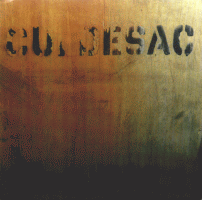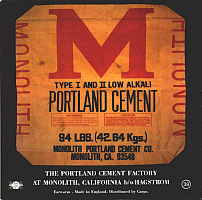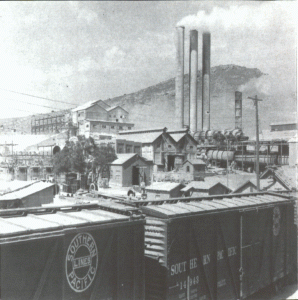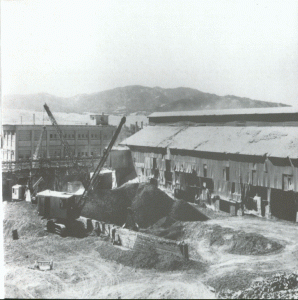The Portland Cement Factory at Monolith, California
Cul de Sac

Cul de Sac, Idaho, 1998
"The Portland Cement Factory at Monolith, California" b/w "Hagstrom"
Earworm. Made in England. Distributed by Cargo.
The standard 94 pound Monolith Portland Cement Company bag
"The Portland Cement Factory at Monolith, California" b/w "Hagstrom"
Earworm. Made in England. Distributed by Cargo.
The standard 94 pound Monolith Portland Cement Company bag

Monolith, California doesn't appear on most contemporary maps. It lies in the hilly southwestern part of California, some 50 miles east of Bakersfield. The nearest city, Tehachapi (famous for its women's prison), is about four miles away.
The story of Monolith Portland Cement begins around the turn of the century when the Los Angeles Board of Public Works set out to supplement its water supply from beyond the Los Angeles basin. By 1906 the City had secured a deed to water from the Owens Valley on the eastern side of the Sierras and begun development of a facility to convey the water to L.A. The construction of a cement plant at Monolith, California was one of the first aspects of the project undertajken by the City. Why Monolith? In addition to its plentiful supply of limestone and clay (needed to make the high-grade cement to be used to construct the aqueducts to carry the water), Monolith was also situated near the geographic center of the proposed transmission site.
The plant was finished in 1908 and operated continuously until 1914, when the L.A. water project was completed and the mill shut down. In 1920 the property was leased to a partnership called the U.S. Potash Company. In june 1921 it was renamed the Monolith Portland Cement Company.
For the next half-century Monolith Portland Cement met the demands of a booming Los Angeles and the rapidly swelling contours of southern California. The architecture of the region still bears traces of the company's goods. Many of the Spanish style homes and businesses in Beverly Hills and Hollywood (built in the '20s) utilised Monolith stucco; the L.A. County Hospital -- a monument to the city -- was constructed from Monolith cements.
In 1941, at the onset of WW II, the U.S. government laid claim to Monolith Portland Cement's raw materials and built the enormous U.S. Naval Ammunition Dump in Hawthorne, Nevada. From 1942 till the end of the war much of the company's output went into construction of a naval base on Guam Island. In the '50s and '60s, Monolith Portland Cement expanded and modernized its facilities, fulfilling southern California's ever-growing highway, utility and building needs.
Early in its history the owners of the company had erected a small tract of modest homes for its employees, and a general store-cum-post office to serve the tiny community. But in 1972, as a way to reduce their maintenance costs, Portland Cement shut down the town and razed the houses.
The story of Monolith Portland Cement begins around the turn of the century when the Los Angeles Board of Public Works set out to supplement its water supply from beyond the Los Angeles basin. By 1906 the City had secured a deed to water from the Owens Valley on the eastern side of the Sierras and begun development of a facility to convey the water to L.A. The construction of a cement plant at Monolith, California was one of the first aspects of the project undertajken by the City. Why Monolith? In addition to its plentiful supply of limestone and clay (needed to make the high-grade cement to be used to construct the aqueducts to carry the water), Monolith was also situated near the geographic center of the proposed transmission site.
The plant was finished in 1908 and operated continuously until 1914, when the L.A. water project was completed and the mill shut down. In 1920 the property was leased to a partnership called the U.S. Potash Company. In june 1921 it was renamed the Monolith Portland Cement Company.
For the next half-century Monolith Portland Cement met the demands of a booming Los Angeles and the rapidly swelling contours of southern California. The architecture of the region still bears traces of the company's goods. Many of the Spanish style homes and businesses in Beverly Hills and Hollywood (built in the '20s) utilised Monolith stucco; the L.A. County Hospital -- a monument to the city -- was constructed from Monolith cements.
In 1941, at the onset of WW II, the U.S. government laid claim to Monolith Portland Cement's raw materials and built the enormous U.S. Naval Ammunition Dump in Hawthorne, Nevada. From 1942 till the end of the war much of the company's output went into construction of a naval base on Guam Island. In the '50s and '60s, Monolith Portland Cement expanded and modernized its facilities, fulfilling southern California's ever-growing highway, utility and building needs.
Early in its history the owners of the company had erected a small tract of modest homes for its employees, and a general store-cum-post office to serve the tiny community. But in 1972, as a way to reduce their maintenance costs, Portland Cement shut down the town and razed the houses.

